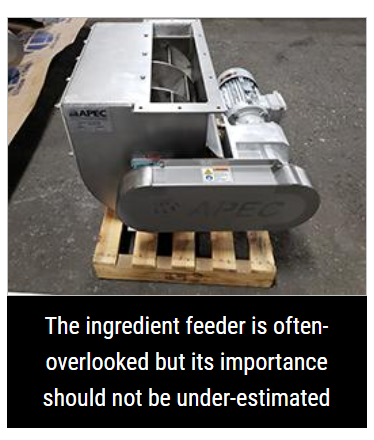Welcome to Sino Bearings web
24x7 HOTLINE:+86-28-81454188

 NEWS
NEWS
Wade Almy reveals how to select the right feeder for your materials
The ingredient feeder is responsible for metering the right amount of ingredients from the source into the next process. This part of the ingredient system is often overlooked, which can cause problems later on. Different materials, particularly fibrous, aeratable, abrasive and cohesive materials, can all create problems in the wrong feeder.
First: assess your materials
Having a good understanding of your materials’ properties will help in selecting the right feeder. It will also help in designing the optimal system overall. If your equipment designer understands the difficult characteristics of your material, they can make adjustments to the feeder and prevent flow and measurement problems. Give your equipment supplier a sample of the materials beforehand, so they can make an assessment.
Consider the following material characteristics, which can cause flow problems at the feeder.
• Aeratable: Aeratable materials are usually fine powders that behave like liquids when aerated. This can cause them to flood hoppers and create hazardous dust clouds.• Abrasive: abrasive materials can wear out your feeder quickly, but the wrong feeder liner can cause the materials to break apart.• Cohesive: cohesive materials tend to stick to each other and form balls or clumps.
Ingredient feeders for aeratable materials
Aeratable materials such as talc powder, flour, glass microspheres and other powders can pose serious hazards without the right feeder design and safeguards. These materials flow like water when aerated, and also create dangerous dust clouds. Dust clouds create debris across the factory, they can be hazardous to workers’ health if inhaled, or a spark, even from static electricity, can cause them to ignite.
One of the most important considerations in selecting a feeder for aeratable materials is dust suppression and collection systems. Fugitive dust can be an issue at various points in the process, including the hopper, feeder, conveyance system and more. Tight seals between these processes will help to keep dust from escaping. However, dust collectors should be used at any point where the material may escape, and regularly assessed to ensure proper airflow.
Besides creating dust, aeratable materials are also prone to flooding. They will flush out of a feed screw and overfill the system if the feeder is not designed properly. A centre rod works better than an open flight in this case. It may also be beneficial to use smaller, more frequent refills to prevent aeration. Vibrators can also help to densify the material and make it easier to work with.
Ingredient feeders for abrasive materials
Abrasive materials can quickly damage the feeder. However, the wrong feeder lining can also damage the material. Selecting the right feeder for abrasive materials means finding a liner suitable for the particle size and hardness of the material.
An abrasion-resistant bolt-in liner made from steel, carbide, or polyethylene can help to protect the feeder. However, this may not be suitable for large particles dropped from a distance. As the hardness and abrasion resistance of the liner increases, it also becomes more brittle, so it will be more susceptible to damage from heavy impacts. This also makes it harder to form and handle, so fabrication will be more challenging. To find the right balance of hardness and abrasion resistance, it’s helpful to have a good material sample and assessment of the overall process.
Ingredient feeders for cohesive materials
Cohesive materials tend to stick to each other and clump together. The first line of defence against this problem is the hopper design. An asymmetrical mass-flow hopper will help to discourage rat-holing. The hopper should also have a completely smooth surface, with no ledges or protruding welds for the material to stick to.
You might use external paddles and a flexible hopper to de-clump the material as it moves into the feeder. Or, a slow-spinning, vertical or horizontal agitator will break up the material before it enters the feeder. Air pads or vibration might also help. However, agitation devices should cycle, not work continuously, or they can cause the material to become airborne or compacted.
A properly designed screw feeder will be best for cohesive materials. The opening from the hopper to the feeder should be as large as possible. A screw with a larger centre shaft, smaller flights and progressive pitch will also help the material fill the screw flights evenly and feed consistently.
Different materials flow in different ways. A feeder that works for one material might not work for another. To select the right feeder for your materials, the best defence is a clear understanding of how the material flows. Giving your equipment manufacturer a sample of your materials and testing the process beforehand will help to ensure your equipment works properly when it’s installed.